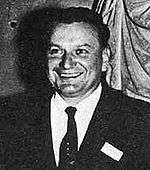Krafft Arnold Ehricke
Krafft Arnold Ehricke (March 24, 1917 – December 11, 1984) was a German rocket-propulsion engineer and advocate for space colonization.
Krafft Arnold Ehricke | |
|---|---|
 Krafft Arnold Ehricke | |
| Born | March 24, 1917 Berlin, Germany |
| Died | December 11, 1984 (aged 67) La Jolla, California, United States |
Biography
Born in Berlin, Ehricke believed in the feasibility of space travel from a very young age, influenced by his viewing of the Fritz Lang film Woman in the Moon. At the age of 12, he formed his own rocket society. He attended Technical University of Berlin and studied celestial mechanics and nuclear physics under such luminaries as Hans Geiger and Werner Heisenberg, attaining his degree in Aeronautical Engineering.[1]
He worked at Peenemünde as a propulsion engineer from 1942 to 1945 with Walter Thiel, then went to the United States with other German rocket scientists and technicians under "Operation Paperclip" in 1947. He worked for a short time with the Von Braun Rocket Team at Huntsville.
In 1948, while working for the U.S. Army, Ehricke wrote a story about a manned mission to Mars called "Expedition Ares". It anticipated the many challenges that still face explorers who will make the journey in the future. In the same year he wrote a book with Wernher von Braun, The Mars Project, which detailed how man could travel to Mars using a ferry system.
Upon leaving government service Ehricke worked at Bell Aircraft, and then for Convair in 1952. While at Convair, he designed the D-1 Centaur, the world's first upper-stage-booster that used liquid hydrogen and oxygen.[1][2] He also created an early space station design, based on launch by Convair's Atlas rocket. The NEXUS reusable rocket was a 1960s concept design by a group at General Dynamics led by Krafft Ehricke. Also, during his stay at General Dynamics, he participated on Project Orion (nuclear propulsion).
In 1966, Ehricke was inducted into the International Aerospace Hall of Fame for his engineering achievements and his influential ideas on the purpose of space exploration.[3]
Krafft Ehricke undertook a major, multi-decade study of the industrial development of the Moon, which he described as Earth's "seventh continent." His lunar industrialization concept was based on the most advanced technologies, such as nuclear-powered freight transporters, and using fusion energy to power his city, Selenopolis, on the Moon.
Ehricke received a space burial on April 21, 1997, when a rocket sent a small amount of his cremated remains into Earth orbit.
He married Ingeborg Ehricke (born 12 September 1922).[4]
Contributions to space flight dynamics
Ehricke was an accomplished practitioner in the field of astrodynamics and its applications. His two-volume work entitled Space Flight is probably the most complete and surely the most useful introduction to this complex subject ever written. It focuses on methods for exploration of the solar system. Although he was not the first, he clearly demonstrated the so-called "gravity assist" method for utilizing hyperbolic encounters with an intermediate planet to increase (or decrease) the velocity and orbital elements of a space vehicle.[5] This technique had opened the entire solar system to robotic exploration by using what he called "Instrumented Comets." Examples include the Voyager missions to the outer planets and the recent successful New Horizons mission to Pluto. His contribution to this important field of exploration has been neglected for many decades and incorrect claims of "invention" of what is now called gravity assist were made by Minovitch.
Extraterrestrial Imperative
Ehricke promoted a philosophical concept called the "Extraterrestrial Imperative." This idea refers to Ehricke's belief that it was the responsibility of humanity to explore space and exploit the resources of the Solar System, in order to sustain the development of the species. There are no external "limits to growth," Ehricke insisted, because while the Earth is a "closed system," the exploration of space opens the universe to humanity. For Ehricke, human creativity has no limits.[6][7]
Further reading
- Freeman, Marsha (2009). Krafft Ehricke's extraterrestrial imperative. Burlington Ontario: Apogee Books. ISBN 978-1-894959-91-9.
References
- "Ehricke". Astronautix.com. Archived from the original on 2010-10-19. Retrieved 2010-08-29.
- "Ehricke, Krafft Arnold (1917-1984)". Daviddarling.info. 2007-02-01. Retrieved 2010-08-29.
- Sprekelmeyer, Linda, editor. These We Honor: The International Aerospace Hall of Fame. Donning Co. Publishers, 2006. ISBN 978-1-57864-397-4.
- Biography for Krafft Arnold Ehricke on IMDb
- Negri, Rodolfo Batista; Prado, Antônio Fernando Bertachini de Alme (14 July 2020). "A historical review of the theory of gravity-assists in the pre-spaceflight era". Journal of the Brazilian Society of Mechanical Sciences and Engineering. 42 (8). doi:10.1007/s40430-020-02489-x.
- Ehricke, Krafft, "The Extraterrestrial Imperative," Air University Review, January–February 1978
- "Krafft Ehricke Extraterrestrial Imperative by Marsha Freeman An Apogee Books Publication". Apogeespacebooks.com. Retrieved 2010-08-29.
External links
| Wikiquote has quotations related to: Krafft Arnold Ehricke |
- www.hq.nasa.gov
- www.daviddarling.info
- www.tdf.it
- Ehricke, Krafft@ Astrophysics Data System
- Krafft Arnold Ehricke (in German) from the archive of the Österreichische Mediathek